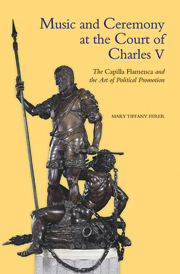 Music and Ceremony at the Court of Charles V
Music and Ceremony at the Court of Charles V Book contents
- Frontmatter
- Contents
- List of Illustrations
- List of Tables
- Preface and Acknowledgements
- List of Abbreviations
- Dedication
- Chapter 1 Charles V: Defender of the Faith and Universal Monarch
- Chapter 2 The Genesis of the Chapel
- Chapter 3 The Reconstruction of the Capilla Flamenca
- Chapter 4 The Chapel Ordinances: Ritual and Repertory at the Court
- Chapter 5 Music and Ceremony at the Court of Charles V
- Chapter 6 Charles V as Crusader and Christian Knight
- Chapter 7 The Presentation of the Emperor
- APPENDIX A Chapel Rosters
- APPENDIX B Chapel Statutes and Ordinances
- APPENDIX C Selected Chapel Personnel
- APPENDIX D Musical Manuscripts, Prints, and Editions
- Glossary
- Bibliography
- Index
Chapter 2 - The Genesis of the Chapel
Published online by Cambridge University Press: 05 October 2013
- Frontmatter
- Contents
- List of Illustrations
- List of Tables
- Preface and Acknowledgements
- List of Abbreviations
- Dedication
- Chapter 1 Charles V: Defender of the Faith and Universal Monarch
- Chapter 2 The Genesis of the Chapel
- Chapter 3 The Reconstruction of the Capilla Flamenca
- Chapter 4 The Chapel Ordinances: Ritual and Repertory at the Court
- Chapter 5 Music and Ceremony at the Court of Charles V
- Chapter 6 Charles V as Crusader and Christian Knight
- Chapter 7 The Presentation of the Emperor
- APPENDIX A Chapel Rosters
- APPENDIX B Chapel Statutes and Ordinances
- APPENDIX C Selected Chapel Personnel
- APPENDIX D Musical Manuscripts, Prints, and Editions
- Glossary
- Bibliography
- Index
Summary
THE BURGUNDIAN AND SPANISH INHERITANCE
In what has been described as ‘the greatest armada ever seen’ a fleet of 133 ships and an escort of 15,000 men set sail from Spain for the Low Countries in August 1496. Aboard was Juana of Castile, third child and second daughter of Isabella of Castile and Ferdinand of Aragon, rulers of Spain, on her way to the Low Countries to marry the Archduke of Burgundy, Philip the Fair, and, in so doing, advance Spanish interests in the region and forge an alliance between Spain and the Holy Roman Empire against France. The marriage was celebrated on 20 October 1496.
A daughter, Eleanor, was born on 15 November 1498. Two years later a son arrived, born on 24 February 1500 at the Prinsenhof in Ghent; he was named Charles after his paternal great-grandfather Charles the Bold, Duke of Burgundy. His baptism on the evening of 7 March was celebrated with the kind of elaborate ceremonies that would accompany significant milestones throughout his life. Te contemporary chronicler Jean Molinet reported that
… the people of Ghent had constructed a wooden gangway 1 metre high, 2 metres wide and 700 metres long, along which the procession could make its way from the Prinsenhof to St John's Church, visible to and unhindered by the people. Te gangway was decorated with three times thirteen gates, some of which were larger than the others and had allegorical names: the Gates of Wisdom, Justice and Peace. All the gates were decorated with coats of arms and torches, 10,000 of them altogether, according to the candlemakers’ guild involved. On the Lys the clarions sounded from a brilliantly lit ship and the dragon on the belfry spewed fireworks. A walkway had been stretched between the spires of the belfry and the church of St Nicholas. The designer of the spectacle walked on planks above his construction to place a cartwheel with torches on top of the spire of St Nicholas’ church. As was customary, some three or four hundred dignitaries took part in the procession. First, the masters and administrators of the craft guilds, the town magistrates, knights and squires of the court, members of the Council of Flanders, knights in the Order of the Golden Fleece and, lastly, the close relatives of the young prince.
- Type
- Chapter
- Information
- Music and Ceremony at the Court of Charles VThe Capilla Flamenca and the Art of Political Promotion, pp. 26 - 65Publisher: Boydell & BrewerPrint publication year: 2012
